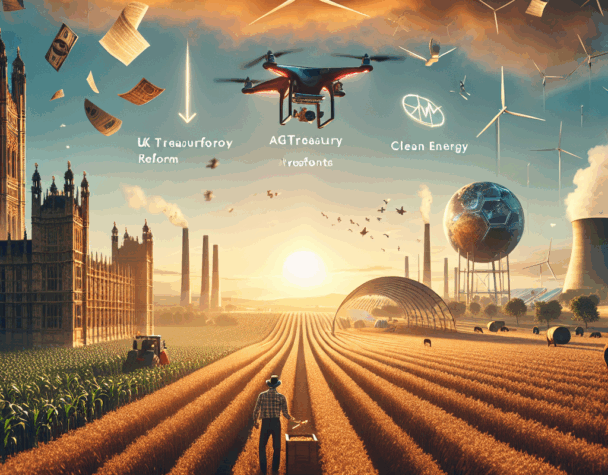
Global Investment Trends: UK Treasury Reforms, AgTech Capital Shifts, and Clean Energy Investments
Sat, June 21, 2025UK Treasury Reforms Aim to Boost Economic Growth
UK Finance Minister Rachel Reeves has prioritized boosting economic growth, yet current plans to increase investment may fall short. She has adjusted fiscal rules to enable £113 billion in extra investment over five years, channeling funds into key areas such as housing, infrastructure, and energy. However, the Office for Budget Responsibility predicts capital spending will peak at 3.9% of GDP in 2027/2028 before declining again, indicating persistent underinvestment since the 2008 financial crisis. The government is exploring other growth avenues including deregulatory measures and pension fund investment. Yet, rigid fiscal rules and centralized Treasury control hinder long-term strategic planning. Calls for structural reform include suggestions from the IMF advocating a more flexible fiscal approach, and proposals from political groups to overhaul or even abolish the Treasury. Reeves is modestly reforming Treasury project evaluation rules and involving the OBR in assessing long-term impacts. Nonetheless, critics argue that a fundamental recalibration of governmental machinery is essential to break the UK’s cycle of low growth and productivity. This could involve balancing Treasury power with a dedicated economic growth ministry. While ensuring fiscal discipline remains crucial, market sentiment may favor a coherent, investment-driven growth strategy. (reuters.com)
AgTech Sector Faces Capital Drought Amid Economic Challenges
The U.S. AgTech sector is facing a capital downturn due to macroeconomic challenges, low commodity prices, and a weak agricultural cycle, resulting in a 25% decline in venture deals and a 3.6% drop in funding in Q1 2025. Despite this, niche areas such as precision farming, dairy, and solar land management remain promising. Precision agriculture, bolstered by labor shortages and growing interest in automation and robotics, recorded $1.82 billion in deal value over 12 months, with substantial growth in robotics and smart field equipment. California-based Monarch Tractor highlighted rising demand for its autonomous feed-pushing technology in dairy farms and for robotic maintenance services in solar farms driven by the AI data center expansion. Industry giants like John Deere and Caterpillar are bolstering their automation ventures, indicating potential market maturity and strategic consolidation. Analysts predict a market rebound in the latter half of 2025, potentially favoring scalable and established AgTech players, provided there are no prolonged trade disruptions. (reuters.com)
Global Shift Towards Clean Energy Investments
Global energy investment is increasingly favoring clean technologies over fossil fuels, with the International Energy Agency (IEA) reporting $2.2 trillion in investments for renewables, storage, nuclear, and grid technologies in 2025—twice the amount allocated to coal, gas, and oil. Electricity investments now significantly outpace those for fossil fuels, although global demand for traditional energy sources like coal, oil, and gas continues to rise, driven especially by growth in China and India. Meanwhile, clean energy spending is concentrated in fossil fuel-importing nations, highlighting a shift towards domestic energy sources amid global trade uncertainties and deglobalization trends. A notable analysis even suggests that Donald Trump’s protectionist and isolationist policies may inadvertently accelerate clean energy adoption as countries move away from imported fuels. In the U.S., proposed changes to the Inflation Reduction Act (IRA) could cut projected renewable energy capacity by 10% by 2035. Additionally, the rapidly expanding energy needs of data centers may require over $170 billion in new power generation investments, further driving both clean and fossil fuel spending. Despite recent setbacks in green finance, existing projects are still receiving substantial funding, although new approvals face uncertainty from evolving fiscal and political landscapes. (axios.com)
India Emerges as Top Investment Destination in Asia-Pacific
India has emerged as the crown jewel of the Asia-Pacific investment landscape, according to Bank of America’s May 2025 survey of regional fund managers. Surpassing Japan and leaving China far behind, India now ranks as the most favored market, thanks to a unique blend of economic resilience, policy reforms, and global supply chain shifts. A dramatic rise in investor sentiment—from a net 13% underweight in March to a staggering 42% overweight in May—highlights the growing confidence in India’s growth story. (moneycontrol.com)
Gold Investment Demand Surges Amid Economic Uncertainty
Global gold investment demand soared 170% year-on-year in Q1 2025, driven largely by a surge in gold-backed ETF inflows. ETF holdings jumped by 226 tonnes globally, with strong contributions from Europe, Asia, and India amid rising economic uncertainty. (businesstoday.in)
Conclusion
The global investment landscape is undergoing significant transformations, with the UK implementing Treasury reforms to stimulate growth, the U.S. AgTech sector navigating capital challenges, and a worldwide shift towards clean energy investments. India’s emergence as a top investment destination and the surge in gold demand further underscore the dynamic nature of current investment trends. Investors should stay informed and adapt to these evolving opportunities and challenges.

